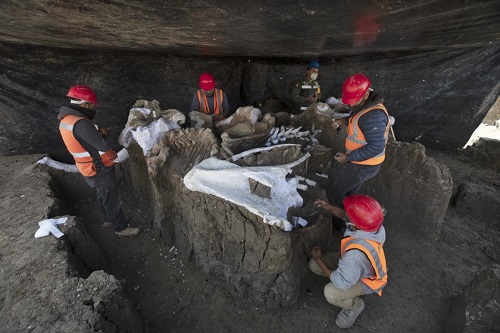 Friday, April 19, 2024
Friday, April 19, 2024  Friday, April 19, 2024
Friday, April 19, 2024 
The number of mammoth skeletons recovered at an airport construction site north of Mexico City has risen to at least 200, with a large number still to be excavated, experts said Thursday.
Archeologists hope the site that has become “mammoth central” — the shores of an ancient lake bed that both attracted and trapped mammoths in its marshy soil — may help solve the riddle of their extinction.
Experts said that finds are still being made at the site, including signs that humans may have made tools from the bones of the lumbering animals that died somewhere between 10,000 and 20,000 years ago.
There are so many mammoths at the site of the new Santa Lucia airport that observers have to accompany each bulldozer that digs into the soil to make sure work is halted when mammoth bones are uncovered.
“We have about 200 mammoths, about 25 camels, five horses,” said archeologist Rubén Manzanilla López of the National Institute of Anthropology and History, referring to animals that went extinct in the Americas.
The site is only about 12 miles from artificial pits, essentially shallow mammoth traps, that were dug by early inhabitants to trap and kill dozens of mammoths.
Manzanilla López said evidence is beginning to emerge suggesting that even if the mammoths at the airport died natural deaths after becoming stuck in the mud of the ancient lake bed, their remains may have been carved up by humans. Something similar happened at the mammoth-trap site in the hamlet of San Antonio Xahuento, in the nearby township of Tultepec.